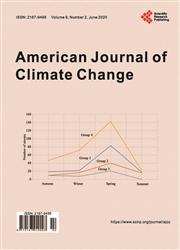Seasonal Analysis of Atmospheric Changes in Hudson Bay during 1998-2018
引用次数: 4
Abstract
The main objective of this study is to examine the NARR (North American Regional Reanalysis Model) high-resolution dataset to understand the last two decades dramatic climate changes in Hudson Bay associated with the atmospheric keys by synoptically analysis. The anomalies of the near-surface meteorological parameters such as air temperature, humidity, mean sea level pressure, wind vectors along with cloudiness, precipitation, surface albedo and downward longwave radiation at surface in seasonally based changes have been analysed. The increase in low-level thermal structure leads to changing the near-surface humidity, evaporation, cloudiness, precipitation and downward longwave radiation at the surface. Also, winds have been accelerated associated with anticyclonic curvature development. The results show significant atmospheric changes during the last two decades in Hudson Bay with the highest values mostly during winter and fall seasons in the north, east boundaries and James Bay area. Using the statistical analysis for mean low-level temperature, surface albedo, low-level clouds and evaporation at the surface during nearly recent 2 decades (1998-2018) rather than the normal climatology mean (1981-2010) have revealed the meaningful significant difference for mentioned parameters. The statistical analysis results show that during spring there is a significant positive correlation between low clouds anomaly and 2 m air temperature anomaly rather than other seasons. So, the recent atmospheric changes in the study area as a region located in the Arctic and sub-Arctic can contribute to extra-local and global warming.1998-2018年哈德逊湾大气变化的季节分析
本研究的主要目的是对NARR(北美区域再分析模式)高分辨率数据集进行天气学分析,以了解哈德逊湾近20年来与大气关键因素相关的剧烈气候变化。分析了气温、湿度、平均海平面气压、风矢量与云量、降水、地表反照率、地表向下长波辐射等近地表气象参数的季节变化异常。低层热结构的增加导致地表近地面湿度、蒸发、云量、降水和向下长波辐射的变化。此外,风的加速与反气旋曲率的发展有关。结果表明,哈德逊湾近20年来大气变化显著,其中北部、东部边界和詹姆斯湾地区的冬季和秋季变化最大。利用近20 a(1998—2018年)而非正常气候学平均值(1981—2010年)的低层平均温度、地表反照率、低层云量和地表蒸发量的统计分析,揭示了上述参数的显著差异。统计分析结果表明,春季低云异常与2 m气温异常存在显著正相关关系,其他季节除外。因此,研究区作为一个位于北极和亚北极的区域,最近的大气变化可以促进局外和全球变暖。
本文章由计算机程序翻译,如有差异,请以英文原文为准。
求助全文
约1分钟内获得全文
求助全文

 求助内容:
求助内容: 应助结果提醒方式:
应助结果提醒方式:


